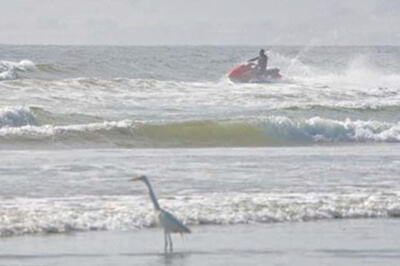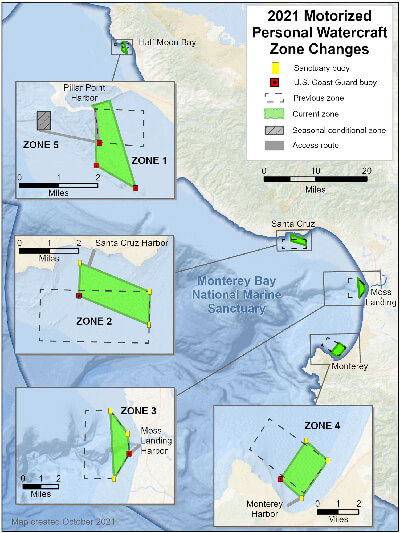Impacts of Personal Watercrafts on Marine Wildlife

Conservation Issue
The ability of Monterey Bay National Marine Sanctuary (MBNMS) managers to educate the public about the impacts of motorized personal watercraft (MPWC) use would be considerably enhanced by a comprehensive literature review of documented MPWC interactions with marine wildlife such as seabirds, marine mammals, and turtles.
Description
MPWCs are small, fast, and highly maneuverable craft that possess unconventionally high thrust capability and horsepower relative to their size and weight. This characteristic enables them to make sharp turns at high speeds and to unpredictably accelerate and decelerate while maintaining controlled stability. MPWC activities have increased in the MBNMS with the development of larger and more powerful vehicles for use in the marine environment. In contrast to the impacts of conventional motorboats, which transit nearshore areas fairly quickly by maintaining steady speeds and bearings, wildlife disturbance impacts from MPWCs tend to be more severe due to repeated disruptions and accumulated impacts in nearshore areas. Sanctuary regulations are designed to minimize disturbance of marine wildlife and other ocean users by restricting the use of MPWCs to five designated zones and access routes within MBNMS. A comprehensive literature review summarizing existing studies on MPWC interactions with marine species such as seabirds, marine mammals, and turtles is needed to help MBNMS stakeholder groups understand the risks MPWCs pose to these particularly vulnerable types of wildlife.
Data and Analysis Needs
- MPWC impacts to wildlife at the surface and underwater, including the nature of those impacts (e.g., visual, audible, physical)
- Species-specific vulnerability to MPWC disturbance
- Marine wildlife species that use the surf zone in central California and how this varies seasonally
- Information on whether marine wildlife species remain in the surf zone during periods of high surf (≥15-foot breakers) and where and for how long they relocate if not
- Wildlife activities (e.g., feeding, breeding, nesting) that are more likely than others to be impacted by MPWC use
- MPWC management strategies that have been shown to reduce the frequency and severity of wildlife disturbance
- Analysis of existing regulations governing MPWC use in MBNMS

Potential Products
- Expanded and updated technical information on both design of MPWCs and effects on wildlife to support future sanctuary management planning, natural resource protection, and public education and outreach
- Literature review data available to the public online
- Presentation on information learned from a literature review for stakeholder groups interested in the regulation of MPWCs in the MBNMS
- Enhanced signage and educational materials to increase public awareness
Suggested Scientific Approach and Actions
- Develop an inventory of existing studies focused on MPWC impacts in both California and non-California marine environments
- Document and summarize scientific findings about impacts to wildlife from MPWC operations
- Analyze the relevance of MPWC impact analyses from non-California marine study areas to MBNMS
- Evaluate trends in disturbance and review the extent to which MPWC management has led to improvements
Key Partners
NOAA’s National Marine Mammal Laboratory, U.S. Fish and Wildlife Service, Surfrider Foundation, Monterey Bay Aquarium, National Park Service, Audubon Canyon Ranch, NOAA Library, university and college libraries, U.S. Environmental Protection Agency, state/county wildlife and natural resource agencies, California Department of Boating and Waterways, state boating agencies
For more information about this assessment, contact Karen.Grimmer@noaa.gov.

